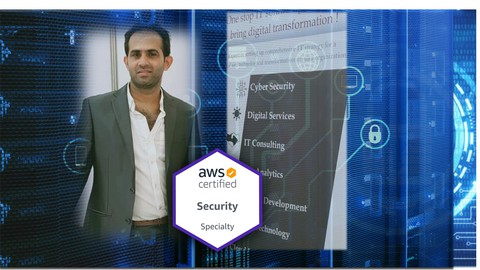
AWS-Security-Specialty Exam
AWS-Security-Specialty Exam, available at $19.99, 3 quizzes.
You will learn about Knowledge of the AWS shared responsibility model and its application Security controls for workloads on AWS Logging and monitoring strategies Cloud security threat models Patch management and security automation Ways to enhance AWS security services with third-party tools and services and disaster recovery This course is ideal for individuals who are The exam is open to anyone who currently holds a Cloud Practitioner or Associate-level certification. We recommend candidates have five years of IT security experience designing and implementing security solutions, and at least two years of hands-on experience securing AWS workloads. It is particularly useful for The exam is open to anyone who currently holds a Cloud Practitioner or Associate-level certification. We recommend candidates have five years of IT security experience designing and implementing security solutions, and at least two years of hands-on experience securing AWS workloads.
Enroll now: AWS-Security-Specialty Exam
Summary
Title: AWS-Security-Specialty Exam
Price: $19.99
Number of Quizzes: 3
Number of Published Quizzes: 3
Number of Curriculum Items: 3
Number of Published Curriculum Objects: 3
Number of Practice Tests: 3
Number of Published Practice Tests: 3
Original Price: $19.99
Quality Status: approved
Status: Live
What You Will Learn
- Knowledge of the AWS shared responsibility model and its application
- Security controls for workloads on AWS
- Logging and monitoring strategies
- Cloud security threat models
- Patch management and security automation
- Ways to enhance AWS security services with third-party tools and services and disaster recovery
Who Should Attend
- The exam is open to anyone who currently holds a Cloud Practitioner or Associate-level certification. We recommend candidates have five years of IT security experience designing and implementing security solutions, and at least two years of hands-on experience securing AWS workloads.
Target Audiences
- The exam is open to anyone who currently holds a Cloud Practitioner or Associate-level certification. We recommend candidates have five years of IT security experience designing and implementing security solutions, and at least two years of hands-on experience securing AWS workloads.
Introduction
The AWS Certified Security – Specialty (SCS-C01) exam is intended for individuals who perform a security role. The exam validates a candidate’s ability to effectively demonstrate knowledge about securing the AWS platform.
The AWS Certified Security – Specialty (SCS-C01) exam is a pass or fail exam. The exam is scored against a minimum standard established by AWS professionals who follow certification industry best practices and guidelines. Your results for the exam are reported as a scaled score of 100–1,000. The minimum passing score is 750. Your score shows how you performed on the exam as a whole and whether or not you passed. Scaled scoring models help equate scores across multiple exam forms that might have slightly different difficulty levels.
This exam guide includes weightings, test domains, and objectives for the exam. It is not a comprehensive listing of the content on the exam. However, additional context for each of the objectives is available to help guide your preparation for the exam.
Domain 1: Incident Response
1.1 Given an AWS abuse notice, evaluate the suspected compromised instance or exposed access keys.
– Given an AWS Abuse report about an EC2 instance, securely isolate the instance as part of a forensic investigation.
– Analyze logs relevant to a reported instance to verify a breach, and collect relevant data.
– Capture a memory dump from a suspected instance for later deep analysis or for legal compliance reasons.
1.2 Verify that the Incident Response plan includes relevant AWS services.
– Determine if changes to baseline security configuration have been made.
– Determine if list omits services, processes, or procedures which facilitate Incident Response.
– Recommend services, processes, procedures to remediate gaps.
1.3 Evaluate the configuration of automated alerting, and execute possible remediation of securityrelated incidents and emerging issues.
– Automate evaluation of conformance with rules for new/changed/removed resources.
– Apply rule-based alerts for common infrastructure misconfigurations.
– Review previous security incidents and recommend improvements to existing systems.
Domain 2: Logging and Monitoring
2.1 Design and implement security monitoring and alerting.
– Analyze architecture and identify monitoring requirements and sources for monitoring statistics.
– Analyze architecture to determine which AWS services can be used to automate monitoring and alerting.
– Analyze the requirements for custom application monitoring, and determine how this could be achieved.
– Set up automated tools/scripts to perform regular audits.
2.2 Troubleshoot security monitoring and alerting.
– Given an occurrence of a known event without the expected alerting, analyze the service functionality and configuration and remediate.
– Given an occurrence of a known event without the expected alerting, analyze the permissions and remediate.
– Given a custom application which is not reporting its statistics, analyze the configuration and remediate.
– Review audit trails of system and user activity.
2.3 Design and implement a logging solution.
– Analyze architecture and identify logging requirements and sources for log ingestion.
– Analyze requirements and implement durable and secure log storage according to AWS best practices.
– Analyze architecture to determine which AWS services can be used to automate log ingestion and analysis.
2.4 Troubleshoot logging solutions.
– Given the absence of logs, determine the incorrect configuration and define remediation steps.
– Analyze logging access permissions to determine incorrect configuration and define remediation steps.
– Based on the security policy requirements, determine the correct log level, type, and sources.
Domain 3: Infrastructure Security
3.1 Design edge security on AWS.
– For a given workload, assess and limit the attack surface.
– Reduce blast radius (e.g. by distributing applications across accounts and regions.)
– Choose appropriate AWS and/or third-party edge services such as WAF, CloudFront and Route 53 to protect against DDoS or filter application-level attacks.
– Given a set of edge protection requirements for an application, evaluate the mechanisms to prevent and detect intrusions for compliance and recommend required changes.
– Test WAF rules to ensure they block malicious traffic.
3.2 Design and implement a secure network infrastructure.
– Disable any unnecessary network ports and protocols.
– Given a set of edge protection requirements, evaluate the security groups and NACLs of an application for compliance and recommend required changes.
– Given security requirements, decide on network segmentation (e.g. security groups and NACLs) that allow the minimum ingress/egress access required.
– Determine the use case for VPN or Direct Connect.
– Determine the use case for enabling VPC Flow Logs.
– Given a description of the network infrastructure for a VPC, analyze the use of subnets and gateways for secure operation.
3.3 Troubleshoot a secure network infrastructure.
– Determine where network traffic flow is being denied.
– Given a configuration, confirm security groups and NACLs have been implemented correctly.
3.4 Design and implement host-based security.
– Given security requirements, install and configure host-based protections including Inspector, SSM.
– Decide when to use host-based firewall like iptables.
– Recommend methods for host hardening and monitoring.
Domain 4: Identity and Access Management
4.1 Design and implement a scalable authorization and authentication system to access AWS resources.
– Given a description of a workload, analyze the access control configuration for AWS services and make recommendations that reduce risk.
– Given a description how an organization manages their AWS accounts, verify security of their root user.
– Given your organization’s compliance requirements, determine when to apply user policies and resource policies.
– Within an organization’s policy, determine when to federate a directory services to IAM.
– Design a scalable authorization model that includes users, groups, roles, and policies.
– Identify and restrict individual users of data and AWS resources.
– Review policies to establish that users/systems are restricted from performing functions beyond their responsibility, and also enforce proper separation of duties.
4.2 Troubleshoot an authorization and authentication system to access AWS resources.
– Investigate a user’s inability to access S3 bucket contents.
– Investigate a user’s inability to switch roles to a different account.
– Investigate an Amazon EC2 instance’s inability to access a given AWS resource.
Domain 5: Data Protection
5.1 Design and implement key management and use.
– Analyze a given scenario to determine an appropriate key management solution.
– Given a set of data protection requirements, evaluate key usage and recommend required changes.
– Determine and control the blast radius of a key compromise event and design a solution to contain the same.
5.2 Troubleshoot key management.
– Break down the difference between a KMS key grant and IAM policy.
– Deduce the precedence given different conflicting policies for a given key.
– Determine when and how to revoke permissions for a user or service in the event of a compromise.
5.3 Design and implement a data encryption solution for data at rest and data in transit.
– Given a set of data protection requirements, evaluate the security of the data at rest in a workload and recommend required changes.
– Verify policy on a key such that it can only be used by specific AWS services.
– Distinguish the compliance state of data through tag-based data classifications and automate remediation.
– Evaluate a number of transport encryption techniques and select the appropriate method (i.e. TLS, IPsec, client-side KMS encryption.)
Disclaimers:
-
Numnore Courses Practice Tests are not related to, affiliated with, endorsed or authorized by Amazon.
-
Trademarks, Certification & Product names are used for reference only and belong to Amazon.
Course Curriculum
Instructors
-
Numnore Courses
IT course
Rating Distribution
- 1 stars: 0 votes
- 2 stars: 0 votes
- 3 stars: 0 votes
- 4 stars: 0 votes
- 5 stars: 0 votes
Frequently Asked Questions
How long do I have access to the course materials?
You can view and review the lecture materials indefinitely, like an on-demand channel.
Can I take my courses with me wherever I go?
Definitely! If you have an internet connection, courses on Udemy are available on any device at any time. If you don’t have an internet connection, some instructors also let their students download course lectures. That’s up to the instructor though, so make sure you get on their good side!
You may also like
- Top 10 Financial Technology Courses to Learn in December 2024
- Top 10 Agile Methodologies Courses to Learn in December 2024
- Top 10 Project Management Courses to Learn in December 2024
- Top 10 Leadership Skills Courses to Learn in December 2024
- Top 10 Public Speaking Courses to Learn in December 2024
- Top 10 Affiliate Marketing Courses to Learn in December 2024
- Top 10 Email Marketing Courses to Learn in December 2024
- Top 10 Social Media Management Courses to Learn in December 2024
- Top 10 SEO Optimization Courses to Learn in December 2024
- Top 10 Content Creation Courses to Learn in December 2024
- Top 10 Game Development Courses to Learn in December 2024
- Top 10 Software Testing Courses to Learn in December 2024
- Top 10 Big Data Courses to Learn in December 2024
- Top 10 Internet Of Things Courses to Learn in December 2024
- Top 10 Quantum Computing Courses to Learn in December 2024
- Top 10 Cloud Computing Courses to Learn in December 2024
- Top 10 3d Modeling Courses to Learn in December 2024
- Top 10 Mobile App Development Courses to Learn in December 2024
- Top 10 Graphic Design Courses to Learn in December 2024
- Top 10 Videography Courses to Learn in December 2024






















